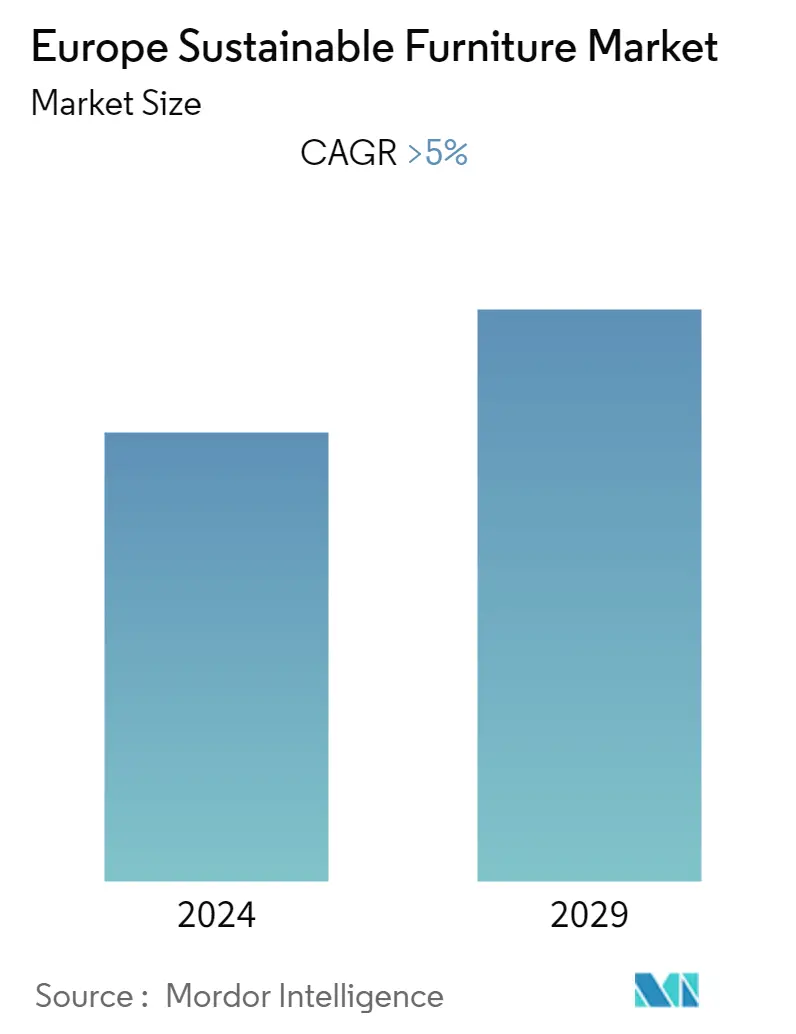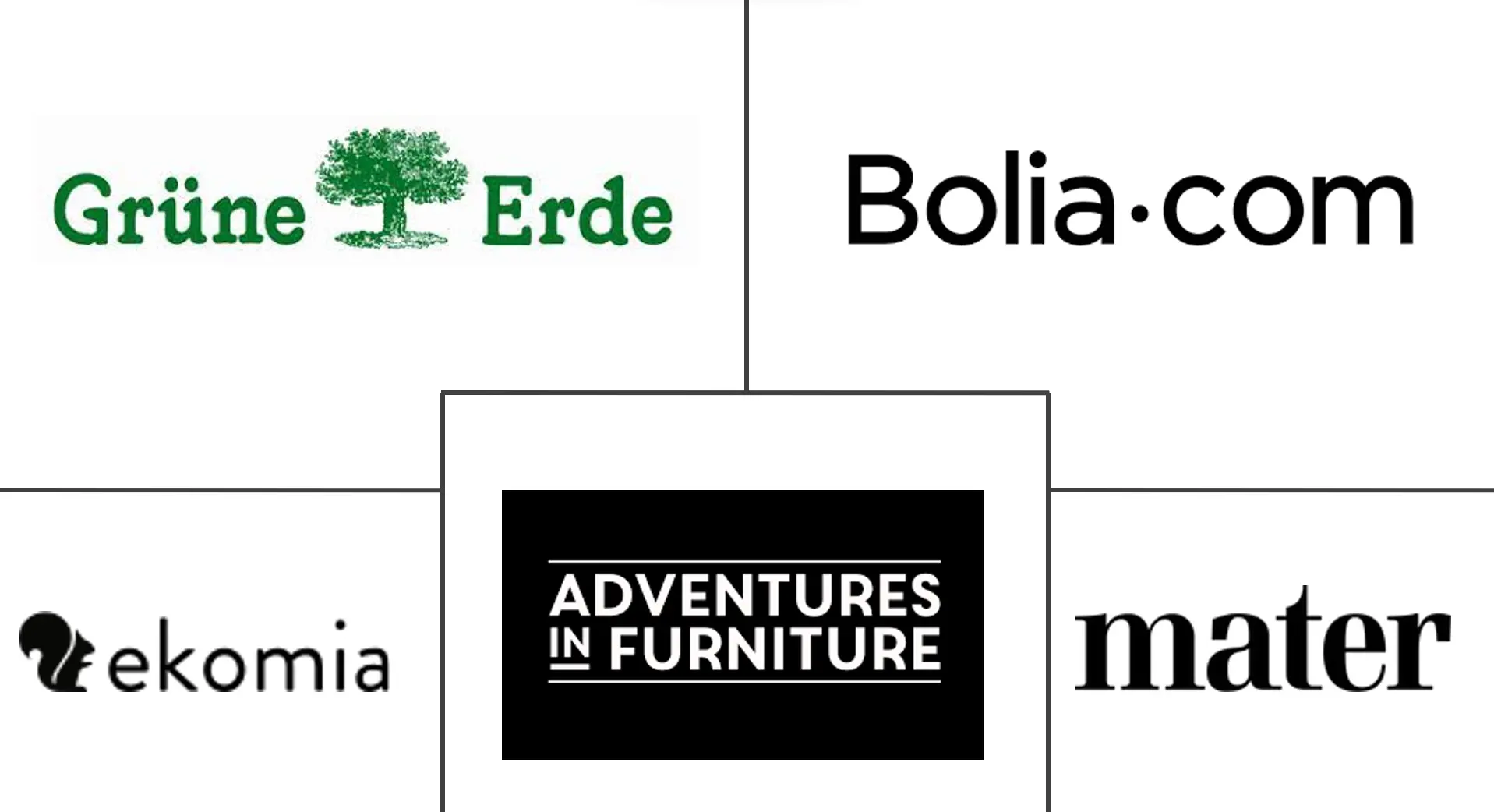Market Size of Europe Sustainable Furniture Industry

| Study Period | 2020 - 2029 |
| Base Year For Estimation | 2023 |
| Forecast Data Period | 2024 - 2029 |
| Historical Data Period | 2020 - 2022 |
| CAGR | > 5.00 % |
| Market Concentration | Medium |
Major Players
*Disclaimer: Major Players sorted in no particular order |
Europe Sustainable Furniture Market Analysis
The demand for sustainable furniture dropped in 2020 as offices, schools, and restaurants temporarily closed to limit the spread of COVID-19. Brands across all industries have been promoting their eco-friendliness throughout their value chain, from sourcing to packaging to end-of-life disposal. The market for sustainable furniture is gaining traction as a result of this trend. Eco-friendly furniture is growing more popular not only in affluent countries, but also in underdeveloped countries.
For furniture producers and buyers, the concept of eco-friendly has been broadening. The goal of proponents of eco-friendly furniture is to use materials and procedures that have a low environmental impact. As a simple, straightforward concept, it might mean that furniture and accessories are made from certified sustainable wood that includes recycled and natural resources.
In a similar line, sustainable furniture industry stakeholders emphasise the growing importance of furniture that does not wind up in landfills, reducing the pressure on recyclability infrastructure. In a broader sense, it might imply that environmentally friendly manufacturing techniques fall under the category of earth-friendly items in the eco-friendly furniture industry. The concept also incorporates the use of environmentally friendly packaging, as well as eco-friendly glues and varnishes.
Europe Sustainable Furniture Industry Segmentation
Sustainable furniture, is an emerging concept, and largely includes furniture made from eco-friendly or recycled materials that are sustainably sourced. Some of the prevalent raw materials used for green furniture include recycled textiles, oak, birch, hemp, wood, and bamboo. A complete analysis of the Europe Sustainable Furniture Market, which includes an assessment of the emerging market trends by segments, significant changes in the market dynamics, and the market overview is covered in the report. The Europe Sustainable Furniture Market is segmented By Application (Residential and Commercial), By Material (Wood, Bamboo, PET, Others), By Distribution Channel (Online and Offline), By Country (Germany, United Kingdom, France, Italy, Spain, and Rest of Europe).
| By Application | |
| Residential | |
| Commercial |
| By Material | |
| Wood | |
| Bamboo | |
| PET | |
| Others |
| By Distribution Channel | |
| Online | |
| Offline |
| By Geography | |
| Germany | |
| United Kingdom | |
| France | |
| Spain | |
| Italy | |
| Rest of Europe |
Europe Sustainable Furniture Market Size Summary
The European sustainable furniture market is experiencing a resurgence as brands emphasize eco-friendliness across their value chains, from sourcing to disposal. This trend is gaining momentum not only in affluent nations but also in developing regions, as the concept of eco-friendly furniture expands. Stakeholders in the industry are increasingly focusing on materials and processes that minimize environmental impact, such as using certified sustainable wood and environmentally friendly manufacturing techniques. The rise of e-commerce is significantly influencing consumer purchasing patterns, with more customers opting for online shopping due to the convenience and variety it offers. This shift is expected to drive the growth of the sustainable furniture market in Europe, as companies develop online platforms and partnerships with e-commerce retailers to broaden their reach.
The market is moderately consolidated, with major international players and mid-size to smaller companies enhancing their presence through technological advancements and product innovations. The expansion of sustainable furniture makers from Europe into Asia-Pacific emerging countries is anticipated to alter market dynamics, while international trade between European countries and regions like North America and Asia is expected to play a crucial role. Notable developments include Maisons du Monde's marketplace expansion and Herman Miller's initiative to incorporate ocean plastic into its products, reflecting a broader commitment to sustainability. These trends and initiatives are poised to contribute to the continued growth and evolution of the sustainable furniture market in Europe.
Europe Sustainable Furniture Market Size - Table of Contents
-
1. MARKET INSIGHTS AND DYNAMICS
-
1.1 Market Overview
-
1.2 Market Drivers
-
1.3 Market Restraints
-
1.4 Value Chain / Supply Chain Analysis
-
1.5 Porters Five Force Analysis
-
1.5.1 Threat of New Entrants
-
1.5.2 Bargaining Power of Buyers
-
1.5.3 Bargaining Power of Suppliers
-
1.5.4 Threat of Substitute Products
-
1.5.5 Intensity of Competitive Rivalry
-
-
1.6 Insights on Current Trends, Recent Developments and Technological Innovations in the Market
-
1.7 Insights on Government Policies, Initiatives and Industry Regulatory Framework/Standards
-
1.8 Insights on Industry Certifications (such as BIFMA Level, FEMB Level, LEED, others) for Sustainable Furniture
-
1.9 Consumer Preferences and Behavior Analysis
-
1.10 Impact of COVID-19 on the Market
-
-
2. MARKET SEGMENTATION
-
2.1 By Application
-
2.1.1 Residential
-
2.1.2 Commercial
-
-
2.2 By Material
-
2.2.1 Wood
-
2.2.2 Bamboo
-
2.2.3 PET
-
2.2.4 Others
-
-
2.3 By Distribution Channel
-
2.3.1 Online
-
2.3.2 Offline
-
-
2.4 By Geography
-
2.4.1 Germany
-
2.4.2 United Kingdom
-
2.4.3 France
-
2.4.4 Spain
-
2.4.5 Italy
-
2.4.6 Rest of Europe
-
-
Europe Sustainable Furniture Market Size FAQs
What is the current Europe Sustainable Furniture Market size?
The Europe Sustainable Furniture Market is projected to register a CAGR of greater than 5% during the forecast period (2024-2029)
Who are the key players in Europe Sustainable Furniture Market?
Adventures in Furniture, Grüne Erde, Mater, Bolia and Ekomia are the major companies operating in the Europe Sustainable Furniture Market.

